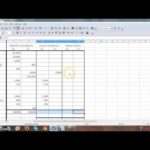
The accrual method posts payroll liabilities and expenses accounting automation in the same period. This reconciliation ensures that the revised liabilities are accurately entered into QuickBooks Online, maintaining the integrity of the payroll system and financial compliance. This article also explains how to use a liability adjustment to correct an employee’s year-to-date information contained in payroll items, such as company contributions, employee addition, and deduction payroll items. On the other hand, QuickBooks Desktop presents a different set of payment methods, including traditional check printing and manual payment processing. The impact of these differences is significant, especially in terms of time-saving and accuracy. QuickBooks Online provides a more streamlined and intuitive user interface, making it easier to navigate through the payroll liabilities process.
The software’s features streamline the process and enhance financial reporting capabilities. Setting up payroll liabilities in QuickBooks Online is a crucial step in ensuring accurate financial records and compliance with tax regulations. Utilizing the software’s features for payroll item setup and liability management streamlines the process and enhances financial reporting capabilities. Managing and paying payroll liabilities in QuickBooks Online involves electronic payment processing, tax deductions, and seamless record-keeping for accurate financial management. Leveraging the software’s features streamlines the payment process and ensures compliance with tax obligations.
Step 2: Enter Year-to-Date Information
Establishing payroll items within QuickBooks Desktop encompasses configuring deductions and categorizing expenses, streamlining accounting tasks and enhancing transaction automation. Even though your employees’ information will be automatically added from Step 4, it’s important that you do review each time in order to lower any chance of mistakes. This step is also where you’ll enter and confirm your hourly employees’ hours worked. Payroll is one of the most time-consuming accounting tasks—and you need the right tools to work efficiently.
- This not only ensures that these payments are made on time but also simplifies the tracking and reporting process.
- If you employ union workers, you must comply with the pay and overtime rates required in the collective bargaining agreement with the union.
- Today, we’ll run through how to do payroll in QuickBooks to save you the hassle (and liability) of making so many mistakes figuring it out on your own.
- In this comprehensive guide, we will walk you through the process of setting up and paying payroll liabilities in both QuickBooks Online and QuickBooks Desktop.
How to Pay Payroll Liabilities in QuickBooks Desktop?
On the other hand, QuickBooks Online simplifies tax-related tasks, providing essential features for filing taxes and managing payroll liabilities efficiently. The payment options differ, with QuickBooks Online offering more flexibility in methods such as direct deposit and e-payment, while QuickBooks Desktop primarily focuses on check payments. Regarding tax deadline management, QuickBooks Online‘s automated reminders and filing assistance stand out, whereas QuickBooks Desktop requires more manual tracking. These disparities contribute to the distinct experiences users encounter when managing payroll liabilities in each platform. Accrued payroll liabilities are the amount a business owes for payroll expenses, including wages, payroll taxes, benefits, and other debts. Accrued payroll includes liabilities a business owes for payroll but hasn’t paid yet.
Once you’ve got the basics of your payroll system set up, it’s time to learn how to use QuickBooks specifically. If you employ union workers, would you please explain unearned income you must comply with the pay and overtime rates required in the collective bargaining agreement with the union. If you use QuickBooks Desktop Payroll Assisted, contact us if you need to make an adjustment for a previously filed tax form or payment. The frequency of filing these forms varies depending on your location and the size of your payroll. This accounting method does not post expenses based on cash inflows and outflows, referred to as the cash basis method of accounting.

How to Zero Out Liabilities in QuickBooks?
Adjusting payroll liabilities in QuickBooks Online involves similar steps to the desktop version, with the added convenience of cloud-based accessibility and collaborative functionality for streamlining the adjustment process. In QuickBooks Online, users have the advantage of leveraging seamless online payment options, offering the convenience of direct deposit and automatic payment processing. The system offers the flexibility to schedule and process payments for payroll liabilities, promoting timeliness and accuracy in discharging these financial responsibilities. If you want to view all of your payroll taxes, you can pull up the Payroll Tax Payments report. I have the steps to help you pay those payroll liabilities and remove the from the balance sheet.
The user interface for managing payroll liabilities differs significantly between QuickBooks Online and QuickBooks Desktop, impacting the accessibility and utilization of various payroll features. Understanding these interface disparities is crucial for efficient payroll management. By setting up scheduled payments, businesses can ensure that their payroll liabilities are consistently funded, avoiding potential penalties or interest charges due to late payments. This also promotes financial planning and organization, as it allows for the predictable allocation of resources for upcoming tax liabilities. With detailed reporting capabilities, businesses can track and verify the accuracy of their tax payments, enhancing overall financial management and accountability. You also need to make sure QuickBooks has all of the information it needs to make your payroll run smoothly.
These tips enhance overall payroll management and mitigate potential tax-related issues. Payroll liabilities occur throughout the payroll process, even before you pay employees. For example, you’ll have payroll liabilities for wages you owe to employees and taxes withheld from their checks when you do pay them.
QuickBooks will save this information in the future, allowing you to skip directly to Step 5. In the meantime, though, here’s the lowdown on the details you’ll need to add. QuickBooks will also ask you for the state in which most of your employees work. If that’s the same state as where your company is based, they’re considered resident employees. QuickBooks will calculate state and local taxes, plus state unemployment insurance, and make appropriate withholdings.
If you need to make adjustments for more than one period, then you must use a separate adjustment transaction for each period. Make sure that the adjustments are correct by selecting the appropriate reports when finished. The available payment options for settling payroll liabilities vary between QuickBooks Online and QuickBooks Desktop, influencing the efficiency of online payments and assignment of contract meaning the overall processing of payroll obligations. Understanding these distinctions is pivotal for selecting the most suitable platform.

Leave a Reply